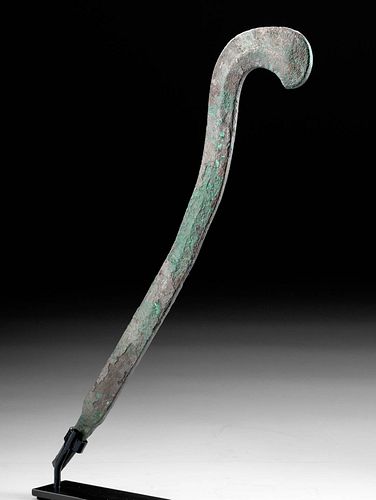Rare Bactrian Copper Mace Headed Sickle Sword
Lot 69c
About Seller
Artemis Gallery
686 S Taylor Ave, Ste 106
Louisville, CO 80027
United States
Selling antiquities, ancient and ethnographic art online since 1993, Artemis Gallery specializes in Classical Antiquities (Egyptian, Greek, Roman, Near Eastern), Asian, Pre-Columbian, African / Tribal / Oceanographic art. Our extensive inventory includes pottery, stone, metal, wood, glass and textil...Read more
Categories
Estimate:
$8,000 - $12,000
Absentee vs Live bid
Two ways to bid:
- Leave a max absentee bid and the platform will bid on your behalf up to your maximum bid during the live auction.
- Bid live during the auction and your bids will be submitted real-time to the auctioneer.
Bid Increments
| Price | Bid Increment |
|---|---|
| $0 | $25 |
| $300 | $50 |
| $1,000 | $100 |
| $2,000 | $250 |
| $5,000 | $500 |
| $10,000 | $1,000 |
| $20,000 | $2,500 |
| $50,000 | $5,000 |
| $100,000 | $10,000 |
| $200,000 | $20,000 |
About Auction
By Artemis Gallery
Feb 13, 2020
Set Reminder
2020-02-13 10:00:00
2020-02-13 10:00:00
America/New_York
Bidsquare
Bidsquare : Exceptional Antiquities, Asian, Ethnographic
https://www.bidsquare.com/auctions/artemis-gallery/exceptional-antiquities-asian-ethnographic-4848
An important one-day auction featuring museum-worthy examples of Egyptian, Greek, Roman, Etruscan, Near Eastern, Far East / Asian, Pre-Columbian, African / Tribal, Oceanic, Native American, Spanish Colonial, Russian, Fossils, Ancient Jewelry, Fine Art, so much more! Artemis Gallery info@artemisgallery.com
An important one-day auction featuring museum-worthy examples of Egyptian, Greek, Roman, Etruscan, Near Eastern, Far East / Asian, Pre-Columbian, African / Tribal, Oceanic, Native American, Spanish Colonial, Russian, Fossils, Ancient Jewelry, Fine Art, so much more! Artemis Gallery info@artemisgallery.com
- Lot Description
Ancient Central Asia, Bactrian, ca. 2500 to 2000 BCE. A rare forged-copper sickle sword similar to the traditional Egyptian khopesh but with a curving profile that gradually widens and terminates in a blunt mace-style head. The blade features a thick spine along the interior curve, a blade edge that narrows near the midsection, a shallow midrib coursing along the entire length, and a slender tang on the base. The lowest point of the bowed top exhibits a petite perforation that was perhaps meant to display additional ornamentation suited to its owner's liking. The tang of the sword would have been fitted into a hilt perhaps made from bone, ivory, or leather, and the entire sword is enveloped in mottled layers of matte patina in hues of green, brown, and russet. Size: 18.1" L x 3.3" W (46 cm x 8.4 cm); 16.6" H (42.2 cm) on included custom stand.
For a couple of strikingly similar examples, please see: Semenenko, Aleksandr Andreyevich. "The Absence of the Sword from Rigveda and Atharvaveda and the Problem of Indo-Aryans' Origin." Journal of Humanities & Social Sciences, Bulletin Social-Economic and Humanitarian Research, No. 1 (3), February 16, 2019, p. 90, fig. 34, top example, and p. 91, fig. 36, third example. DOI: 10.5281/zenodo.2563192
Provenance: private Chicago, Illinois, USA collection, acquired between 2017 and 2020; ex-Michael Pernik collection, Germany, acquired in July 2017; ex-private W.D. collection, Rhineland, Germany
All items legal to buy/sell under U.S. Statute covering cultural patrimony Code 2600, CHAPTER 14, and are guaranteed to be as described or your money back.
A Certificate of Authenticity will accompany all winning bids.
We ship worldwide and handle all shipping in-house for your convenience.
#151827Professionally cleaning and restoration to surfaces. Slight bending to overall form of blade and tang, with light encrustations, softening to midrib, and nicks along peripheries and mace head. Light earthen deposits and fabulous patina throughout.Condition
- Shipping Info
-
All shipping is handled in-house for your convenience. Your invoice from Artemis Gallery will include shipping calculation instructions. If in doubt, please inquire BEFORE bidding for estimated shipping costs for individual items.
-
- Buyer's Premium



 EUR
EUR CAD
CAD AUD
AUD GBP
GBP MXN
MXN HKD
HKD CNY
CNY MYR
MYR SEK
SEK SGD
SGD CHF
CHF THB
THB














